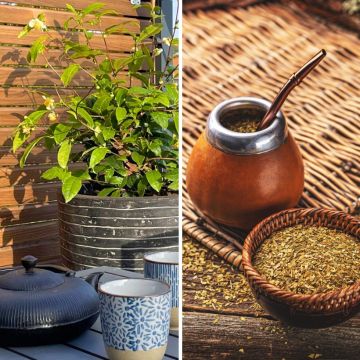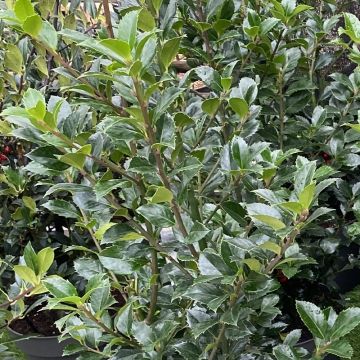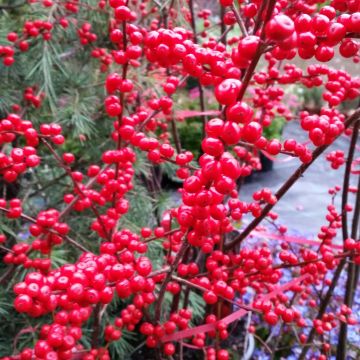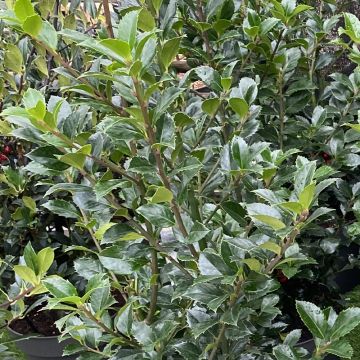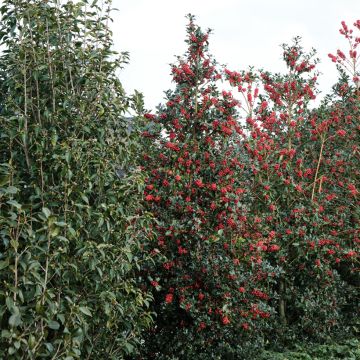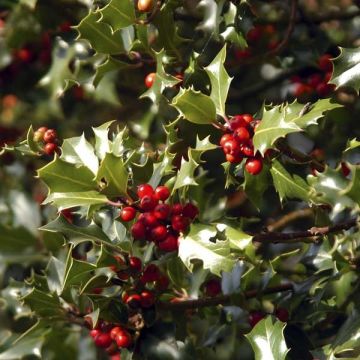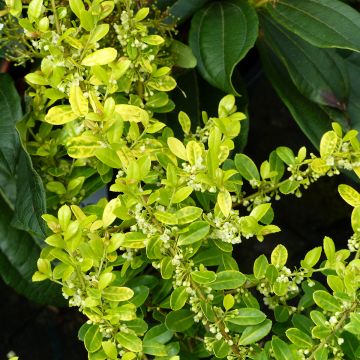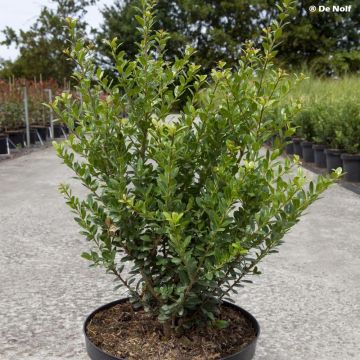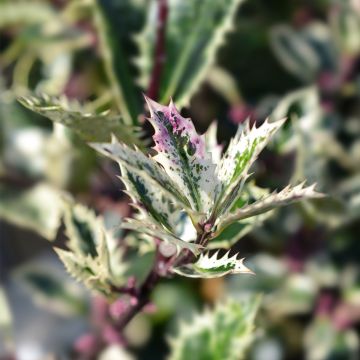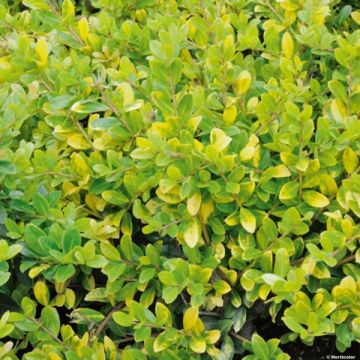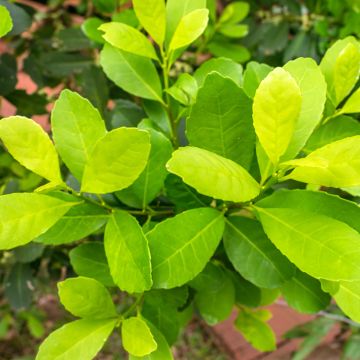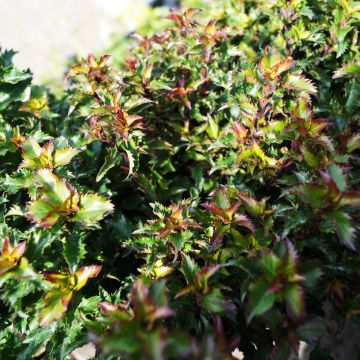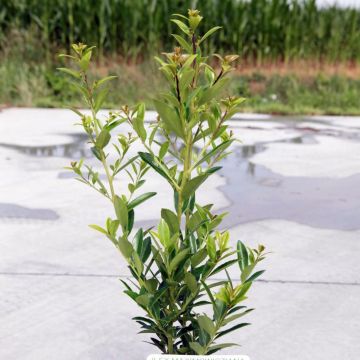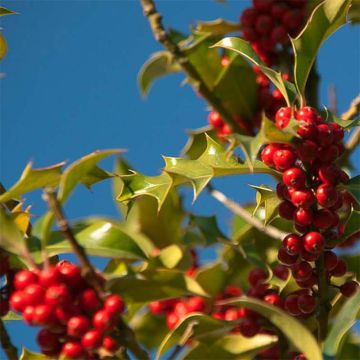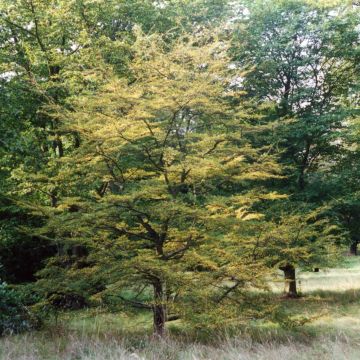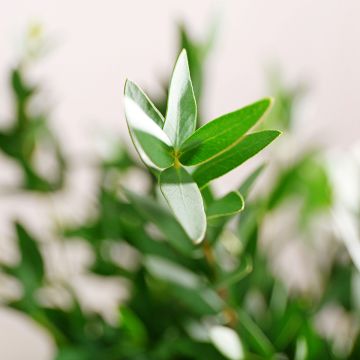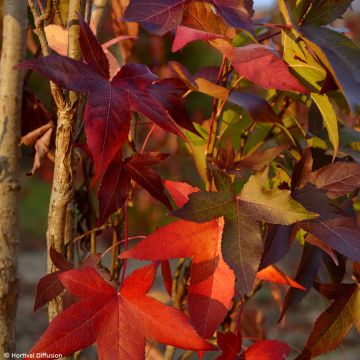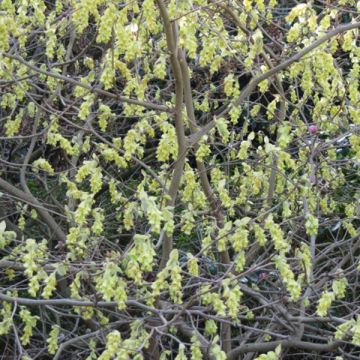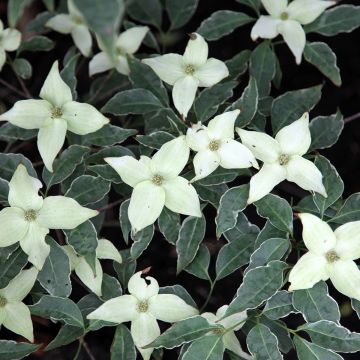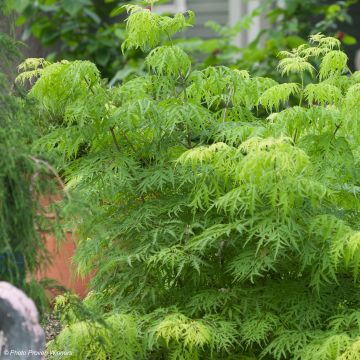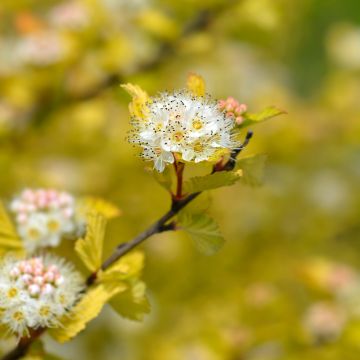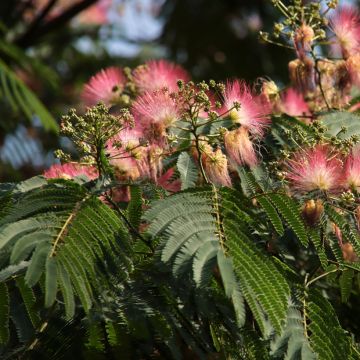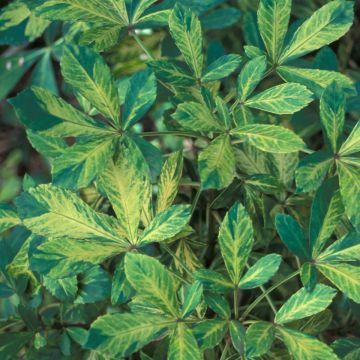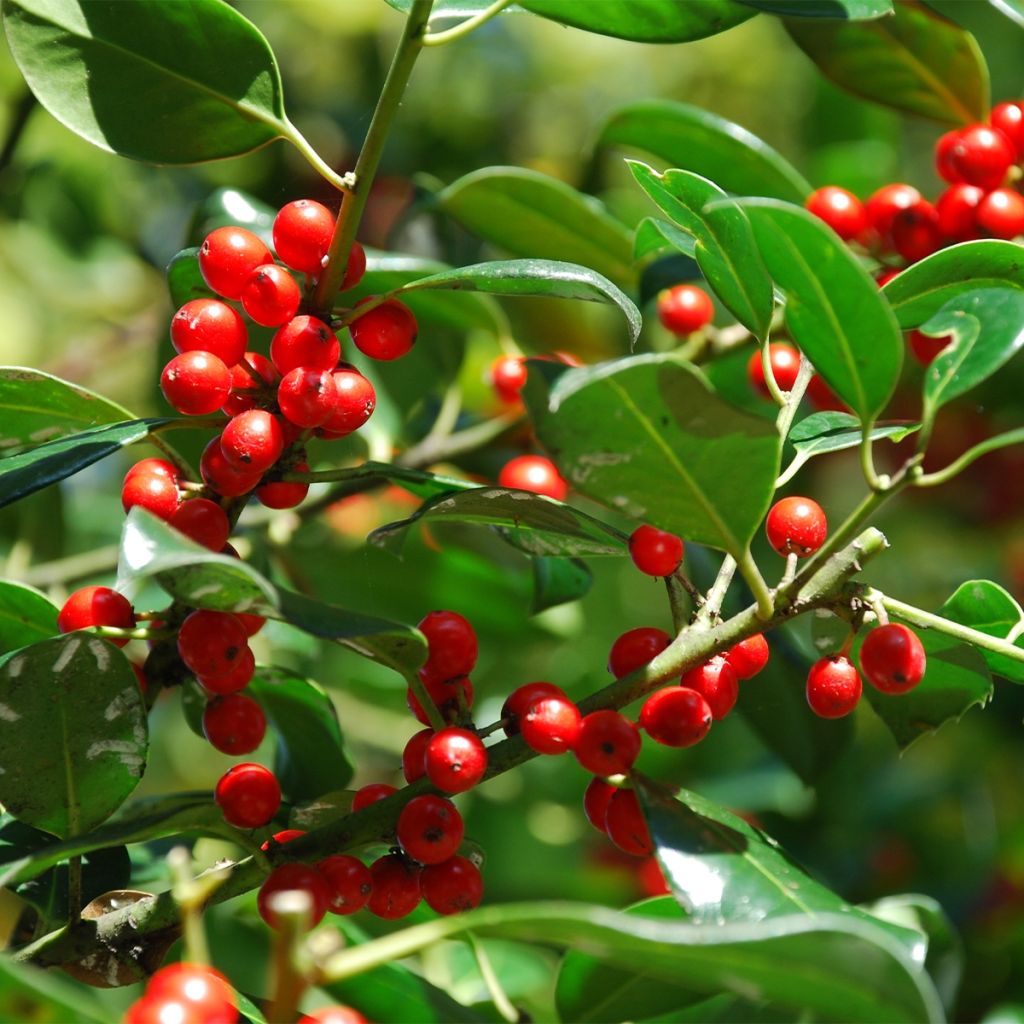

Houx 'Red Dot '


Houx - Ilex rotunda Red Dot
Ilex rotunda Red Dot
Ilex rotunda Red dot (R)
Kurogane holly
Why not try an alternative variety in stock?
View all →This plant carries a 24 months recovery warranty
More information
We guarantee the quality of our plants for a full growing cycle, and will replace at our expense any plant that fails to recover under normal climatic and planting conditions.
From €5.90 for pickup delivery and €6.90 for home delivery
Express home delivery from €8.90.
Delivery to Corse prohibited: UE law prohibits the import of this plant from mainland France to Corse as part of the fight against Xylella fastidiosa. Please accept our sincere apologies.
More information
Does this plant fit my garden?
Set up your Plantfit profile →
Description
Ilex rotunda Red Dot is a recent French variety of this evergreen holly with average hardiness. It is of interest for its non-spiny evergreen foliage, which is a medium green colour and lighter than our common holly. It is especially remarkable for its abundant red berries in autumn and winter. Its growth is relatively fast for a holly, reaching a height of 3m (9 ft 10 in) in 10 years, and it will continue to grow taller. It can be grown in full sun or partial shade, in limestone-free, neutral or slightly acidic soil, and it prefers moist conditions. A unique and attractive plant for regions with a not too harsh climate.
Hollies belong to the Aquifoliaceae family, which have a unique genus (some classifications also include Nemopanthus). Most of them are evergreen and often spiny, but some are deciduous. They range in size from shrubs to trees, growing in temperate climates to tropical zones. The most well-known is Ilex aquifolium, our common holly that can be found in our woodlands, and which has given rise to numerous cultivars.
This genus is also found in Asia, notably with the species rotunda originating from China, Korea, Taiwan, Vietnam and Japan. Ilex rotunda, also known as Kurogane Holly, grows in evergreen broadleaved forests, often in fairly sunny areas such as forest edges or slopes. At maturity, it can reach a height of 18m (59 ft 1 in). This species was first described in 1784 by Carl Peter Thunberg, the Swedish naturalist and pupil of Linnaeus. It is an official tree of several Japanese municipalities and is one of the Hibakujumoku trees, meaning it survived the nuclear bombings in Hiroshima and Nagasaki - the above-ground parts of trees located 3 km (1.9 mi) from the impact were destroyed but regrew from the stump.
Ilex rotunda Red Dot (R) 'Minzong' cov is its full name and it is a recent creation from the Minier nurseries near Angers, which has been granted a plant variety certificate in 2020 (equivalent to a patent for plant varieties). Its characteristics are not yet fully established, particularly its estimated hardiness of -12°C (10.4 °F) to-15°C (5 °F), which could be improved, but this still needs to be tested. Similarly, its size after 10 years of planting is known, about 3m (9 ft 10 in) in height and width, with an annual growth of about 40cm (15.7 in). Its adult height, on the other hand, is estimated at 5m (16 ft 5 in) but this could reach 8m (26 ft 2 in) in open spaces.
This large shrub has a fairly upright habit in its early years and then becomes more rounded with age. Its foliage is a beautiful medium green, lighter than the common holly species we are accustomed to. Its non-spiny leaves are a beautiful light green when they first appear, before darkening slightly. Obovate in shape (wider near the tip than at the petiole), with a very slight point at the end, they are glossy, as if coated with varnish. Its branching is dense and can be further enhanced by a spring pruning, which it tolerates very well.
Its discreet white flowering in May-June transforms into beautiful decorative red fruits from October to December. It is a self-fertilising female variety, guarenteeing an autumn show! Its spherical berries can be so plentiful on a branch that the leaves no longer have room. When birds finish eating the berries, some branches can then be left bare, but they can be pruned to stimulate new shoots. These very attractive fruits are toxic and can cause some gastric problems.
Red Dot grows in full sun or partial shade, in limestone-free soil, neutral to moderately acidic, rich in humus and fertile. It does not tolerate drought and will require watering in summer. It should be planted in a location sheltered from cold winter winds.
This exotic holly will delight enthusiasts of decorative fruiting plants. To create an autumnal scene of interest, you can associate it with other shrubs with decorative berries that have the same requirements. In the foreground of your flowerbed, opt for the Skimmia japonica Kew White with its spherical white fruits that contrast well with the reds of the Holly. Among the deciduous ones, the Clerodendrum trichotomum has star-shaped and highly visible late summer flowers that are pleasantly scented. It is followed by magnificent fruits, resembling precious jewels, consisting of a turquoise blue pearl set in a bright red calyx. Equally unknown despite its equally astonishing fruits, the Decaisnea fargesii is also native to China. This shrub is adorned with beautiful cream-yellow cluster-like flowers, which turn into large elongated turquoise-colored pods in autumn.
Report an error about the product description
Ilex rotunda Red Dot in pictures




Plant habit
Flowering
Foliage
Botanical data
Ilex
rotunda
Red dot (R)
Aquifoliaceae
Kurogane holly
Cultivar or hybrid
Other Ilex - Holly
Planting and care
Choose a sheltered location from winter cold winds to install this Red Dot Holly. It requires a neutral to acidic, fertile and humus-rich soil that remains moist throughout the year. A good garden soil is therefore suitable, but if your soil is a bit poor, you can remedy this by digging a planting hole large enough, at least 60 to 70 cm (23.6 to 27.6 in) in all directions, to incorporate planting soil and compost that you will mix with the existing soil in equal proportions (one third of each). Soak the root ball of your Holly in a bucket of water for fifteen minutes to moisten it well, then plant it by positioning it in the hole so that the surface of the root ball is level with the existing soil. Fill in and water abundantly.
Water regularly for the first two years, then it will be able to withstand brief dry periods. Mulching with leaves or bark on the surface will help maintain some moisture.
Planting period
Intended location
Care
This item has not been reviewed yet - be the first to leave a review about it.
Striking foliage shrubs
Haven't found what you were looking for?
Hardiness is the lowest winter temperature a plant can endure without suffering serious damage or even dying. However, hardiness is affected by location (a sheltered area, such as a patio), protection (winter cover) and soil type (hardiness is improved by well-drained soil).

Photo Sharing Terms & Conditions
In order to encourage gardeners to interact and share their experiences, Promesse de fleurs offers various media enabling content to be uploaded onto its Site - in particular via the ‘Photo sharing’ module.
The User agrees to refrain from:
- Posting any content that is illegal, prejudicial, insulting, racist, inciteful to hatred, revisionist, contrary to public decency, that infringes on privacy or on the privacy rights of third parties, in particular the publicity rights of persons and goods, intellectual property rights, or the right to privacy.
- Submitting content on behalf of a third party;
- Impersonate the identity of a third party and/or publish any personal information about a third party;
In general, the User undertakes to refrain from any unethical behaviour.
All Content (in particular text, comments, files, images, photos, videos, creative works, etc.), which may be subject to property or intellectual property rights, image or other private rights, shall remain the property of the User, subject to the limited rights granted by the terms of the licence granted by Promesse de fleurs as stated below. Users are at liberty to publish or not to publish such Content on the Site, notably via the ‘Photo Sharing’ facility, and accept that this Content shall be made public and freely accessible, notably on the Internet.
Users further acknowledge, undertake to have ,and guarantee that they hold all necessary rights and permissions to publish such material on the Site, in particular with regard to the legislation in force pertaining to any privacy, property, intellectual property, image, or contractual rights, or rights of any other nature. By publishing such Content on the Site, Users acknowledge accepting full liability as publishers of the Content within the meaning of the law, and grant Promesse de fleurs, free of charge, an inclusive, worldwide licence for the said Content for the entire duration of its publication, including all reproduction, representation, up/downloading, displaying, performing, transmission, and storage rights.
Users also grant permission for their name to be linked to the Content and accept that this link may not always be made available.
By engaging in posting material, Users consent to their Content becoming automatically accessible on the Internet, in particular on other sites and/or blogs and/or web pages of the Promesse de fleurs site, including in particular social pages and the Promesse de fleurs catalogue.
Users may secure the removal of entrusted content free of charge by issuing a simple request via our contact form.
The flowering period indicated on our website applies to countries and regions located in USDA zone 8 (France, the United Kingdom, Ireland, the Netherlands, etc.)
It will vary according to where you live:
- In zones 9 to 10 (Italy, Spain, Greece, etc.), flowering will occur about 2 to 4 weeks earlier.
- In zones 6 to 7 (Germany, Poland, Slovenia, and lower mountainous regions), flowering will be delayed by 2 to 3 weeks.
- In zone 5 (Central Europe, Scandinavia), blooming will be delayed by 3 to 5 weeks.
In temperate climates, pruning of spring-flowering shrubs (forsythia, spireas, etc.) should be done just after flowering.
Pruning of summer-flowering shrubs (Indian Lilac, Perovskia, etc.) can be done in winter or spring.
In cold regions as well as with frost-sensitive plants, avoid pruning too early when severe frosts may still occur.
The planting period indicated on our website applies to countries and regions located in USDA zone 8 (France, United Kingdom, Ireland, Netherlands).
It will vary according to where you live:
- In Mediterranean zones (Marseille, Madrid, Milan, etc.), autumn and winter are the best planting periods.
- In continental zones (Strasbourg, Munich, Vienna, etc.), delay planting by 2 to 3 weeks in spring and bring it forward by 2 to 4 weeks in autumn.
- In mountainous regions (the Alps, Pyrenees, Carpathians, etc.), it is best to plant in late spring (May-June) or late summer (August-September).
The harvesting period indicated on our website applies to countries and regions in USDA zone 8 (France, England, Ireland, the Netherlands).
In colder areas (Scandinavia, Poland, Austria...) fruit and vegetable harvests are likely to be delayed by 3-4 weeks.
In warmer areas (Italy, Spain, Greece, etc.), harvesting will probably take place earlier, depending on weather conditions.
The sowing periods indicated on our website apply to countries and regions within USDA Zone 8 (France, UK, Ireland, Netherlands).
In colder areas (Scandinavia, Poland, Austria...), delay any outdoor sowing by 3-4 weeks, or sow under glass.
In warmer climes (Italy, Spain, Greece, etc.), bring outdoor sowing forward by a few weeks.

































